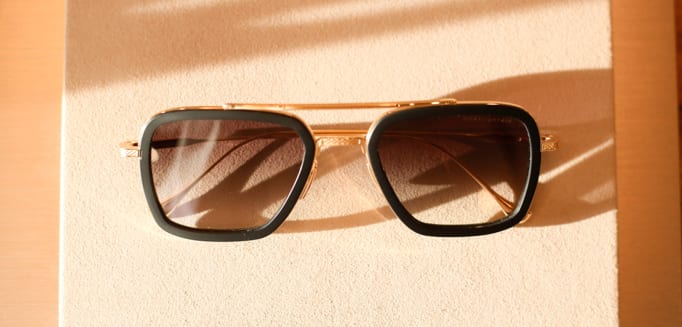Wearing contact lenses can be liberating for those who prefer not to wear glasses. Unfortunately, wearing contact lenses can cause or worsen dry eye symptoms, as contacts reduce the amount of oxygen that the surface of the eye receives, thereby limiting your eyes’ ability to produce natural tears. The resulting irritation can counteract the many benefits that contact lenses offer.
Fortunately, there are ways to deal with these symptoms so you don’t have to give up on wearing contacts.
What Is Dry Eye: Causes, Symptoms, & Risks
Dry eye is a condition that occurs when your eyes don’t produce enough tears or the tears that are produced evaporate too quickly. The different parts of your tear film (your tears) have to work in harmony to keep your eyes adequately lubricated. The layers of the tear film each have a distinct role:
- Mucin Layer: Keeps the tear film fixed to the eye.
- Aqueous Layer: Hydrates & nourishes the eye.
- Lipid Layer: Prevents tears from evaporating too quickly & keeps the eye’s surface smooth.
When one or more of these layers are lacking or malfunctioning, dry eye symptoms can appear. The primary causes of dry eye include environmental factors like wind and smoke, certain medications that reduce tear production, and medical conditions such as Sjögren’s syndrome. Allergies and age are also significant contributors. Tear glands may also produce fewer tears as people age, making the dry eye more prevalent among older adults.
Dry eye is a common issue that can affect anyone, but contact lens wearers may be more susceptible.
If left untreated, dry eyes can lead to complications such as eye infections or damage to the eye’s surface. Chronic dry eye can also impede daily activities like reading or using a computer, significantly impacting quality of life. Therefore, recognizing the symptoms early and seeking appropriate treatment is crucial for maintaining eye health.
How Do Contacts Cause Dry Eyes?
Contact lenses float on a thin layer of tears on the cornea. They require moisture to remain comfortable and practical. Unfortunately, lenses can absorb tears, reducing the eye’s natural lubrication. This absorption can lead to dryness and discomfort, especially in environments with low humidity or extended screen time.
Various other factors can also cause contacts to cause dry eye symptoms, including:
- Contact lenses made from materials that don’t allow enough oxygen to reach the eyes
- Cleaning solutions containing preservatives that may irritate sensitive eyes
- Wearing the wrong prescriptions
- Overwear of contacts
How Do You Know If Your Contacts Are Causing Dry Eye?
Paying close attention to your symptoms can help you determine what’s causing them. If you experience issues like red eyes and stinging sensations more often when you wear contact lenses, that might be a sign that your contacts are causing your symptoms or making them worse.
Dry eye symptoms can vary in intensity and occur for many reasons, so it’s important to get an eye exam if you experience them often. We can provide insights into whether your lenses might be the cause and suggest appropriate remedies or changes in your lens-wearing habits to help.
Treating Dry Eye from Contacts
Several effective treatments are available for managing dry eyes caused by contact lenses.
- Artificial tears provide temporary relief by supplementing the natural tear film. They can be used throughout the day as needed to maintain comfort. Our eye doctors at Foresee Eyecare prefer preservative free artificial tears that can be used with and without contact lenses on.
- Switching to a different type of contact lens. Some lenses are specifically designed to retain moisture better than others. Your eye care professional can recommend lenses that suit your needs and lifestyle.
- Prescription medications can include anti-inflammatory drugs that help increase tear production or antibiotics if there’s an associated infection.
- MiBo ThermoFlo is a therapeutic medical device that uses gentle heat to help break down hardened lipids and oil in the eyelid glands. This device is placed over the eyelids with ultrasound gel and then gently massaged deep into the tissue.
- Intense pulsed light (IPL) uses gentle light pulses to target the glands in the eyelids, helping to reduce inflammation, break down hardened oils, and improve moisture retention.
Consulting with an eye care specialist will provide a tailored approach to effectively managing and treating your dry eye condition.
What Kind of Contacts Are Best for Dry Eyes?

Choosing the right contact lenses can make a significant difference in managing dry eyes.
- Silicone hydrogel lenses allow more oxygen to pass through the cornea, maintaining eye health and comfort.
- Daily disposable lenses are replaced every day, reducing the accumulation of deposits that can irritate the eyes. This daily fresh start can help manage dryness more effectively for many wearers.
- Custom-fitted lenses are tailored to the individual’s eye shape and size, ensuring optimal fit and reducing areas where dryness can occur.
Discussing these options with an eye care professional can help determine the best choice for your specific needs.
Tips for Managing Dry Eye While Wearing Contacts
Managing dry eyes effectively involves a combination of good habits and the right products. In combination with discussing options with your optometrist, you can consider making several lifestyle changes that can help keep your eyes hydrated, including:
- Using a humidifier in your home or workspace to maintain moisture in the air
- Staying hydrated by drinking plenty of water to support overall eye health
- Taking regular breaks from screens can alleviate strain and dryness. Implement the 20-20-20 rule (every twenty minutes, take a twenty second break and look at something twenty feet away) to give your eyes a chance to rest.
- Incorporating omega-3 fatty acids into your diet through foods like fish or flax seeds can improve tear quality and reduce inflammation.
These dietary changes, proper lens care, and suitable lens choices create a comprehensive approach to managing dry eyes effectively.
Taking Control of Your Dry Eyes
At Foresee Eyecare, we understand that dry eye syndrome is a chronic condition requiring treatment of different parts of the eye. We also know that dry eyes pose a challenge for contact lens wearers. However, with the proper knowledge and tools, you can enjoy hassle-free wear of your contact lenses.
Contact us today to see how we can help you implement at-home strategies and in-office treatments to make wearing contact lenses easy again.



















